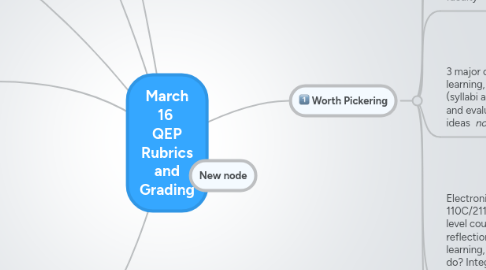
1. Video grading - aka screencast assessment SCREENCAST - capturess what's happening on your screen "live" as you do it, looks and plays like a video on the receiver's end, sot he viewer student: will see paper and be able to follow cursor and hear your responses - student responses to this approach have indicated that it's much more personal
1.1. We could record us talking through a good and bad example and use that from semester to semester. Possibly more effective than a hard copy limited elaboration/notations.
1.2. using jing and email script - Beth will send slides to facilitators to be posted on Blackboard
2. Article from CHL about 5 ways to make grading easier
2.1. "Throw Me a Lifeline"
2.1.1. Grading
2.2. "Throw me a Lifeline"
2.2.1. Rubrics can be tailored to assignment
2.2.1.1. karen uses rubrics in peer reviews as well
2.2.1.1.1. New node
3. Joyce
3.1. What is grading? how well did you do what I told you to do; quantitative What is response? more qualitative and often ongoing if for large project
3.2. Why respond/why grade? when we grade we also respond to justify grade - assignments often vary and don't repeat themselves so a limitation may be if students get responses, they may not be able to apply the responses in another situation - we have to teach them how to transfer our comments to another assignment
3.3. What to respond to? (these 2 are connected though) responses help move student thinking forward; students value responses; acknowledge that we go for the negative What to grade? exams - is the question being answered; did students come up with creative, innovative response - can be a good thing, if response is off topic but it's a good response - can't get a high grade but still gets a grade; grammar; grading for synthesis - "so what" value
3.3.1. When should we respond? common errors - direct response to entire class When should we grade? should be when rested and in decent mood; after providing feedback to students so they can incorporate that feedback
3.4. How should you respond/grade? grammar: positive feedback is necessary but does not warrant a rewrite HOW: comment boxes, rubrics; group's inclination is to be positive rather than just negative What do you do if noone receives an A? is this based on motivation or capabilities?
3.5. Suggestions: HOCS & LOCS HOCS: first areas to focus on - are their ideas strong, focused, worthy? Does the writer understand the details of the topic? HOC is more content higher ordered learning LOCS: more of the mechanical aspects of a paper - still important but if the main areas of learning or objectives are not being met, the LOCS are not where the educational focus should be
3.6. Employ RAFT as a responder as well
4. Dr. Beth Vincelette [email protected]
4.1. Services offered - tutoring, class visits, suggetion to make appointment - walk ins not always accommodated, youtube videos http://www.youtube.com/user/ODUWritingCenter?ob=0&feature=results_main
4.1.1. Ways faculty can use writing center: encourage students to go (extra credit?), let them know what areas you may want covered and they may be able to create a video or presentation of some type that is available to students beyond office hours, provide them with copies of your assignments so they know best how to help students; needs at least 1 week's notice to get a classroom visit http://uc.odu.edu/academicskills/
4.1.1.1. New node
4.2. Video capture responses - digital responses
5. Workshop time: Use what you learned in chapters 14 and 15 to draft a rubric for your assignment. Take advantage of rubistar.4teachers.org. Seek feedback from a colleague on your rubric.
5.1. Now - tell students the role writing plays in our course and why: draft one or more paragraphs for your syllabus - possible topics: why there are writing assignments in your course; why your discipline/profession values writing; how writing supports content learning, etc.
6. Worth Pickering
6.1. Assessing individual assignments
6.2. SACS Philosophy How do we know the extent to which learning has occurred? (handout)
6.3. Writing Tips of the Week information that's going out to all faculty
6.3.1. SACS is peer review process; it's about institutional integrity - we do what we say we will do
6.3.1.1. assessment leads to continuous improvement, focus is on student learning as well as faculty learning
6.3.1.1.1. how do we know student learning has occurred? 5 year term - professional judgment based on..."It/Not It" "I know it when I see it Rubric"
6.4. 3 major components: direct and indirect assessment of student learning, direct and indirect assessment of faculty learning (syllabi assessment, faculty survey of student engagement, and evaluation of implemention of workshop principles and ideas * not an evaluation of job performance*
6.4.1. Rubric developed from VALUE (Value Assessment and Learning in Undergraduate Education)
6.4.1.1. No mechanics feature on QEP Writing Team Rubric: Mechanics should be covered in 100/200 level courses; once students get into actual discipline, it's about content
6.4.1.1.1. Suggestion: share VALUE rubric with students so they may begin assessing their own writing before final submission. Goal for now: 70% of students writing at "meets standard level"
6.5. Electronic Portfolio: Matt Oliver will upload ENGL 110C/211C writings for students and then in our 300/400 level courses, we upload 4 or so pieces of writing - and then reflection essay - represents growth and record of work and learning, more than a resume and transcript -what can you do? Integrative way of learning; for ODU - we will use Blackboard - upload papers
6.5.1. How does this work for transfer students who don't have ENGL 110C and 211C at ODU?
6.5.2. E portfolio book by Terry Rhodes (sp?)
6.5.3. New node
6.6. Reminder - focus of QEP isn't W courses but in reinforcing writing as a way of learning beyond the 100/200 level courses
6.6.1. New node
